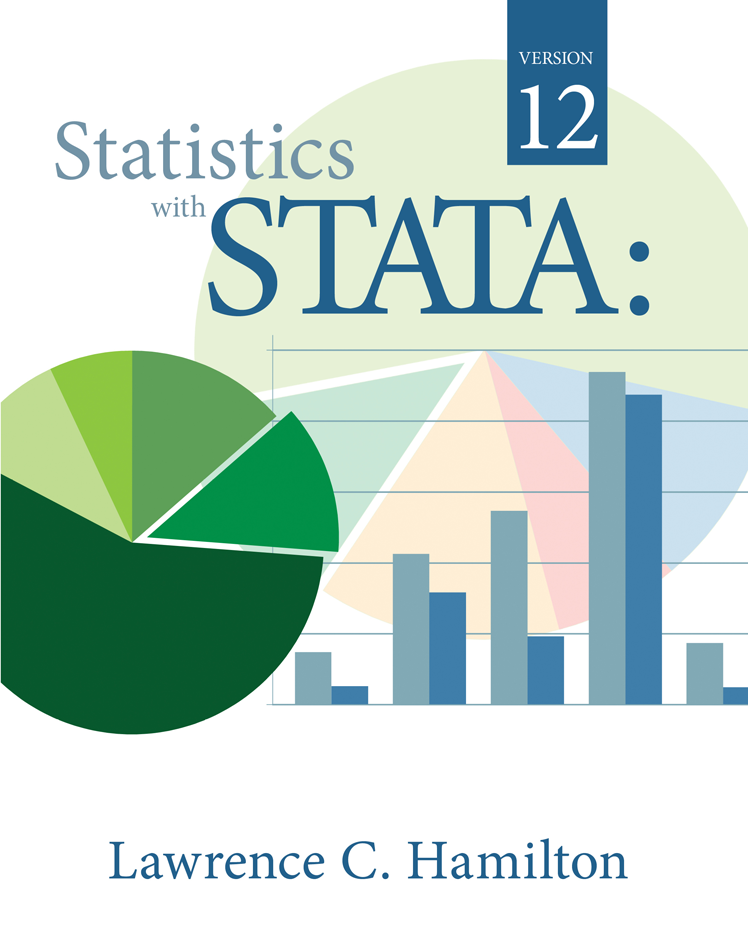| |
Statistics with Stata: Version 12, Eighth Edition
by Lawrence C. Hamilton
 Statistics
with Stata: Version 12 is the latest edition in Professor Lawrence C.
Hamilton’s popular Statistics with Stata series. Intended to bridge the
gap between statistical texts and Stata’s own documentation, Statistics
with Stata demonstrates how to use Stata to perform a variety of tasks. Statistics
with Stata: Version 12 is the latest edition in Professor Lawrence C.
Hamilton’s popular Statistics with Stata series. Intended to bridge the
gap between statistical texts and Stata’s own documentation, Statistics
with Stata demonstrates how to use Stata to perform a variety of tasks.
The first three chapters cover getting started in Stata, data
manipulation, and graphics. Hamilton then introduces many statistical
procedures available within Stata. These include summary statistics and
tables, ANOVA, linear regression (and diagnostics), robust methods,
nonlinear regression, regression models for limited dependent
variables, complex survey data, survival analysis, factor analysis,
cluster analysis, structural equation modeling, multiple imputation,
time series, and multilevel mixed-effects models. The final chapter
provides an introduction to programming.
The organization of this book makes it ideal for those who are new to
statistics, experienced statisticians who are new to Stata, and Stata
users wishing to explore Stata's capabilities in a new field. A series
of example commands with brief descriptions at the beginning of each
chapter demonstrates the Stata syntax for topics discussed in the
chapter. For those already familiar with the statistical technique but
not with the corresponding Stata commands, this example section may be
all that is needed to begin an analysis using Stata. Following the
example sections, Hamilton addresses each topic in more detail with
descriptions of statistical procedures, examples using real data, and
interpretation of the Stata output.
Table of contents
Preface
Notes on the Eighth Edition
Acknowledgments
1 Stata and Stata
Resources
- A Typographical Note
- An Example Stata Session
- Stata's Documentation and Help Files
- Searching for Information
- StataCorp
- Statalist
- The Stata Journal
- Books Using Stata
2 Data Management
- Example Commands
Creating a New Dataset by Typing in Data - Creating a New Dataset by Copy and Paste
Specifying Subsets of the Data: in and if Qualifiers
Generating and Replacing Variables
Missing Value Codes
Using Functions
Converting between Numeric and String Formats
Creating New Categorical and Ordinal Variables
Using Explicit Subscripts with Variables
Importing Data from Other Programs
Combining Two or More Stata Files
Collapsing Data
Reshaping Data
Using Weights
Creating Random Data and Random Samples
Writing Programs for Data Management
3 Graphs
- Example Commands
Histograms
Box Plots - Scatterplots and Overlays
Line Plots and Connected-Line Plots
Other Twoway Plot Types
Bar Charts and Pie Charts
Symmetry and Quantile Plots
Adding Text to Graphs
Graphing with Do-Files
Retrieving and Combining Graphs
Graph Editor
Creative Graphing
4 Survey Data
Example Commands
Declare Survey Data
Design Weights
Poststratification Weights
Survey-Weighted Tables and Graphs
Bar Charts for Multiple Comparisons
5 Summary Statistics and
Tables
- Example Commands
Summary Statistics for Measurement Variables
Exploratory Data Analysis
Normality Tests and Transformations
Frequency Tables and Two-Way Cross-Tabulations
Multiple Tables and Multi-Way Cross-Tabulations
Tables of Means, Medians, and Other Summary Statistics
Using Frequency Weights
6 ANOVA and Other
Comparison Methods
- Example Commands
One-Sample Tests
Two-Sample Tests
One-Way Analysis of Variance (ANOVA)
Two- and N-Way Analysis of Variance
Factor Variables and Analysis of Covariance (ANCOVA)
Predicted Values and Error-Bar Charts
7 Linear Regression
Analysis
- Example Commands
Simple Regression
Correlation
Multiple Regression
Hypothesis Tests
Dummy Variables
Interaction Effects
Robust Estimates of Variance
Predicted Values and Residuals
Other Case Statistics
Diagnosing Multicollinearity and Heteroskedasticity
Confidence Bands in Simple Regression
Diagnostic Graphs
8 Advanced Regression Methods
- Example Commands
Lowess Smoothing
Robust Regression
Further rreg and qreg Applications
Nonlinear Regression — 1
Nonlinear Regression — 2
Box–Cox Regression
Multiple Imputation of Missing Values
Structural Equation Modeling
9 Logistic Regression
- Example Commands
- Space Shuttle Data
- Using Logistic Regression
- Marginal or Conditional Effects Plots
- Diagnostic Statistics and Plots
- Logistic Regression with Ordered-Category y
- Multinomial Logistic Regression
- Multiple Imputation of Missing Values — Logit Regression Example
10 Survival and
Event-Count Models
- Example Commands
- Survival-Time Data
- Count-Time Data
- Kaplan–Meier Survivor Functions
- Cox Proportional Hazard Models
- Exponential and Weibull Regression
- Poisson Regression
- Generalized Linear Models
11 Principal Components,
Factor, and Cluster Analysis
- Example Commands
- Principal Component Analysis and Principal Component Factoring
- Rotation
- Factor Scores
- Principal Factoring
- Maximum-Likelihood Factoring
- Cluster Analysis — 1
- Cluster Analysis — 2
- Using Factor Scores in Regression
Measurement and Structural Equation Models
12 Time Series
Analysis
- Example Commands
- Smoothing
- Further Time Plot Examples
- Recent Climate Change
- Lags, Leads, and Differences
- Correlograms
- ARIMA Models
- ARMAX Models
13 Multilevel and Mixed-Effects Modeling
Example Commands
Regression with Random Intercepts
Random Intercepts and Slopes
Multiple Random Slopes
Nested Levels
Repeated Measurements
Cross-Sectional Time Series
Mixed-Effects Logit Regression
14 Introduction to Programming
Basic Concepts and Tools
Do-files
Ado-files
Programs
Local macros
Global macros
Scalars
Version
Comments
Looping
If ... else
Arguments
Syntax
Example Program: multicat (Plot Many Categorical Variables)
Using multicat
Help File
Monte Carlo Simulation
Matrix Programming with Mata
Dataset Sources
References
Index
© Copyright StataCorp LP 2002-2015.


|
|



